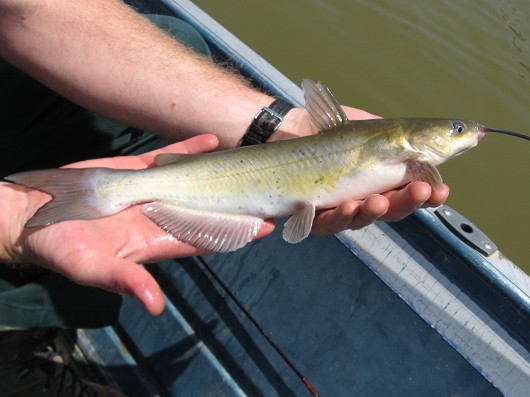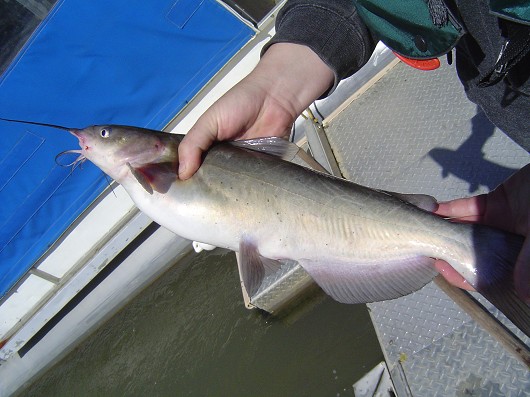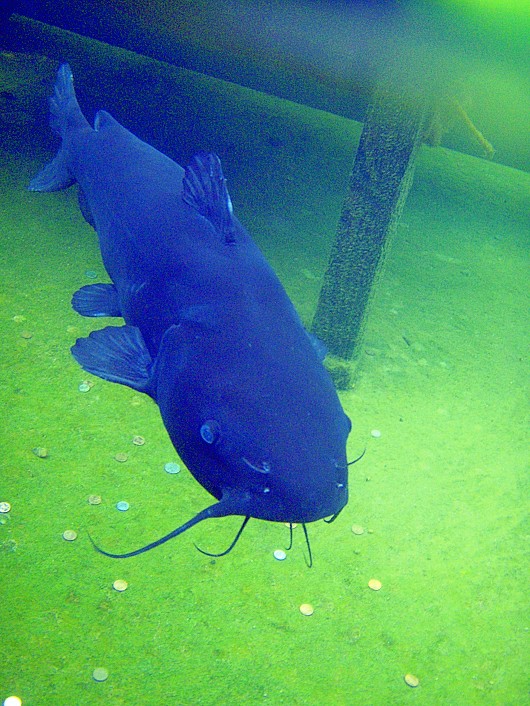Channel catfish
-
Scientific NameIctalurus punctatus
-
NativeNo
-
Identification
 Channel catfish, caught in Nacimiento Reservoir in May 2008 by Teejay O'Rear. Photo by Amber Manfree.
Channel catfish, caught in Nacimiento Reservoir in May 2008 by Teejay O'Rear. Photo by Amber Manfree. Channel catfish, captured in rotary screw trap on Sacramento River at Knight's Landing. Photo by Dan Worth, California Department of Fish and Game.
Channel catfish, captured in rotary screw trap on Sacramento River at Knight's Landing. Photo by Dan Worth, California Department of Fish and Game. Channel catfish. Location: Balboa Park reflecting pond, San Diego, CA, 2009. The fish, estimated to be 10-12 years old, was popular with visitors. It died 24 May 2009, apparently of natural causes. Weight: 10.3 kg (22.7 lb). Photo by Neal Matthews.
Channel catfish. Location: Balboa Park reflecting pond, San Diego, CA, 2009. The fish, estimated to be 10-12 years old, was popular with visitors. It died 24 May 2009, apparently of natural causes. Weight: 10.3 kg (22.7 lb). Photo by Neal Matthews.- Elongate body with a small head
- Deeply forked tail with pointed lobes
- Terminal mouth with 1 black barbel on either side and 4 dusky to white chin barbels
- Maxillary barbels are longer than the head
- Upper jaw protrudes past lower jaw
- Gray-blue on the sides, often with a olive green tinge, fading to white on the belly covered in scattered black spots
- Young have black tipped fins
- Spawning males become dark with enlarged heads, thickened lips, fatty pads behind the eyes, and thickened fin membranes
- Males also have a urogenital papilla extending towards the tail leaving one opening behind the vent compared to the 2 openings on females
- 5-6 soft rays in the dorsal fin
- 24-29 rays in anal fin
- 4-5 soft rays in pectoral fins
-
Life History
Channel catfish are found mostly in the main channels of large, warm water streams with sand, gravel, or rubble bottoms but can also be found in farm ponds, reservoirs, and turbid, muddy bottomed rivers. They are capable of surviving in waters with salinities as high as 10 ppt, temperatures as high as 36-38°C, and dissolved oxygen levels as low as 1-2 mg/L. Adults stay in pools or beneath logjams and undercut banks during the day and move into the faster moving parts of the stream at night to feed. Juveniles are not strong enough swimmers for these currents and instead stay in riffles where the flow is slowed by the rocky bottom. Channel catfish are technically an omnivorous species but they tend to be more predatory in practice. Juveniles feed on crustaceans and insect larvae and will begin hunting fish and crayfish as they grow older. An individual larger than 30-38 cm will focus its diet towards fish but will eat anything from insects to small mammals if it can fit it in its mouth.
Growth is variable depending on location but in good habitat channel catfish will reach a length 7-10 cm in their first year and 35-45 cm in their fifth. Some fish have been found to live longer than 40 years, weigh over 26 kg, and grow to be longer than 1 m but California fish older than 10 years or longer than 53 cm are rare. Reproductive timing is also fairly variable with first spawning points ranging from 2 to 8 years old and lengths between 18 and 56 cm, but the typical maturation point is 3 years old and at least 30 cm in length. Depending on the region, spawning occurs between April and August when temperatures are between 21°C and 29°C. Channel catfish need sheltered, cave-like sites for nests and often use old muskrat burrows, undercut banks, logjams, riprap of large rocks, and even dumped barrels. These may sometimes be difficult to find and while some females may spawn twice in a season it is not uncommon for planted populations to fail to spawn entirely. If an appropriate area is found, males will clear away and protect the nest site before the pair mates. They will mate multiple times until the female lays all her eggs: between 2,000 and 70,000 depending on her size. The males will stay with the nest, fanning it to maximize the oxygen available to the eggs until they hatch 5-10 days later. The 10-12 mm long juveniles start swimming after a couple days but will not leave the protection of the nest and the males until 7 days after hatching. When the juveniles do leave the nest they may school together as a group for some time before departing on their own when they reach approximately 25 mm in length.
-
Links to Other ResearchN / A


